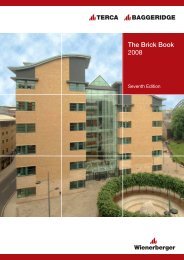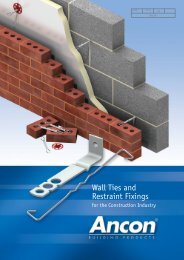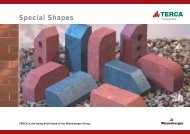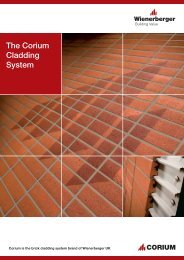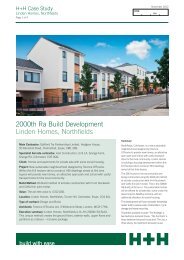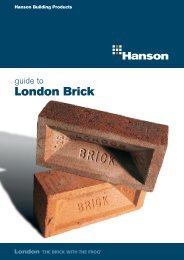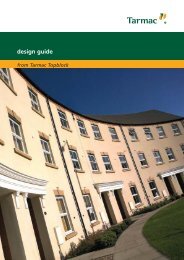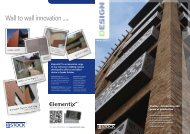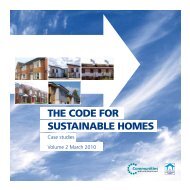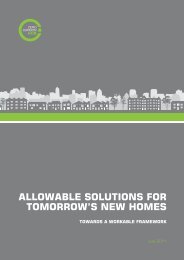BB2-1-Cover FINAL New.qxd:Layout BB - The Brick Development ...
BB2-1-Cover FINAL New.qxd:Layout BB - The Brick Development ...
BB2-1-Cover FINAL New.qxd:Layout BB - The Brick Development ...
- No tags were found...
You also want an ePaper? Increase the reach of your titles
YUMPU automatically turns print PDFs into web optimized ePapers that Google loves.
BRICK BULLETINAUTUMN 2008Kazuyo Sejima’s Tokyo townhousesMartin Pearce profiles Alan ShortHandmade by robot – Bearth & DeplazesSergison Bates in Finsbury ParkClaus & Kaan’s Enschede extravaganzaStephen Taylor and the Surrey vernacular<strong>Brick</strong> testament: Eladio Dieste in Uruguay
BRICK BULLETIN AUTUMN 08ContentsOutdoor activities4 NEWS5 PROJECTSClaus & Kaan in EnschedeStephen Taylor in GomshallKazuyo Sejima in TokyoRobotic brick facades at Bearth& Deplaze’s Swiss winerySergison Bates in Finsbury Park12 PROFILEArchitecture to meet social,practical and artistic ends:Martin Pearce meets architectand academic Alan Short18 PRECEDENTEladio Dieste’s structuralgymnastics in Uruguay22 TECHNICALResearch on the performanceof masonry structures in fireBDA member companies<strong>The</strong> fashion for extravagant form in ourbuilt environment doen’t necessarilymean we have to use novel materials.No one could accuse Alan Short ofmaking dull buildings, yet he uses triedand tested materials that will weatherwell – he wants to make buildings that‘you can leave outdoors’. Likewise,many of the spectacular but littleknownstructures of Uruguayanarchitect-engineer Eladio Dieste arebuilt from a low-maintenance modularcomponent made from baked clay.Meanwhile, thanks for all your nicecomments on the new <strong>Brick</strong> Bulletin –we hope you enjoy this issue as much.Katherina LewisTo find out more about the bricks or pavers in featuredprojects, or to submit projects for possible publication,email brick@brick.org.uk or phone 01344 885651.Blockleys <strong>Brick</strong> t +44 (0)1952 251933 www.michelmersh.comBovingdon <strong>Brick</strong>works t +44 (0)1442 833176 www.bovingdonbricks.co.ukBroadmoor <strong>Brick</strong>works t +44 (0)1594 822255 sales@broadmoor-brickworks.co.ukBulmer <strong>Brick</strong> & Tile Co t +44 (0)1787 269 232 bbt@bulmerbrickandtile.co.ukCaradale Traditional <strong>Brick</strong> t +44 (0)1501 730671 www.caradale.co.ukCarlton <strong>Brick</strong> t +44 (0)1226 711521 www.carltonbrick.co.ukCharnwood Forest <strong>Brick</strong> t +44 (0)1509 503203 www.michelmersh.comChartwell <strong>Brick</strong>works t +44 (0)1732 463712 www.chartwellbrickworks.comColeford <strong>Brick</strong> & Tile t +44 (0)1594 822160 www.colefordbrick.co.ukDunton Brothers t +44 (0)1494 772111 www.michelmersh.comErrol <strong>Brick</strong> t +44 (0)1821 642653 www.errolbrick.co.ukFreshfield Lane <strong>Brick</strong>works t +44 (0)1825 790350 www.flb.uk.comFurness <strong>Brick</strong> & Tile Co t +44 (0)1229 462411 www.furnessbrick.comHammill <strong>Brick</strong> t +44 (0)1304 617613 www.hammillbrick.co.ukHanson Building Products t +44 (0)870 609 7092 www.hanson.co.ukHG Matthews t +44 (0)1494 758212 www.hgmatthews.comIbstock <strong>Brick</strong> t +44 (0)1530 261999 www.ibstock.co.ukLagan <strong>Brick</strong> t +353 (0)42 9667317 www.laganbrick.comMichelmersh <strong>Brick</strong> & Tile t +44 (0)1794 368506 www.michelmersh.comNormanton <strong>Brick</strong> t +44 (0)1924 892142Northcot <strong>Brick</strong> t +44 (0)1386 700551 www.northcotbrick.co.ukOrmonde <strong>Brick</strong> t +353 (0)56 4441323 www.ormondebrick.iePhoenix <strong>Brick</strong> Company t +44 (0)1246 471576 www.bricksfromphoenix.co.ukWm C Reade of Aldeburgh t +44 (0)1728 452982 jha@wmcreade.co.ukSwarland <strong>Brick</strong> Co t +44 (0)1665 574229 chris@swarlandbrick.fsnet.co.ukTower <strong>Brick</strong> & Tile t +44 (0)1420 488489 www.towerbrickandtile.co.ukTyrone <strong>Brick</strong> t +44 (0)28 8772 3421 www.tyrone-brick.com<strong>The</strong> York Handmade <strong>Brick</strong> Co t +44 (0)1374 838881 www.yorkhandmade.co.ukWH Collier t +44 (0)1206 210301 www.whcollier.co.ukWienerberger t +44 (0)161 4918200 www.wienerberger.co.ukFrontispiece Claus &Kaan’s De Eekenhofmixed-use developmentin Enschede, Holland(ph: Christian Richters).<strong>Cover</strong> Seijo townhousesin Tokyo by Kazuyo Sejima(ph: Iwan Baan).Back coverAlan Short (ph: MorganO’Donovan).<strong>Brick</strong> Bulletin Autumn 2008Executive editor: Katherina Lewis tel: 01344 885651 email: brick@brick.org.uk<strong>Brick</strong> <strong>Development</strong> Association, Woodside House, Winkfield, Windsor, Berks SL4 2DX<strong>The</strong> BDA represents the United Kingdom and Ireland’s clay brick and pavermanufacturers and promotes excellence in the architectural, structural and landscapeapplications of brick and pavers. <strong>The</strong> BDA provides practical, technical and aestheticadvice and information through its website www.brick.org.uk, in its numerouspublications and over the phone +44 1344 885651.Published by the BDA ©2008. Editorial and design by Architecture Today plc.2 • <strong>BB</strong> AUTUMN 08 <strong>BB</strong> AUTUMN 08 • 3
NEWSPROJECTSClaus & Kaanin EnschedeLyons Architects in VictoriaMelbourne-based practice Lyons Architectshas completed a visually arresting nursingfacility situated on the edge of a small coastalcommunity in Victoria, south-east Australia.Resembling a large hotel rather than a traditional‘white box’ hospital, Morningtonnursing home is inspired by beachside archi-FAT library for Walsalltecture, including Charles Moore’s SeaRanch in California. <strong>The</strong> two-storey schemetakes the form of a large, folded pitchedroof that encompasses the whole building ina single gesture. <strong>The</strong> exterior is clad in oversized‘timber’ planks renderedin brick. This is intended to give the developmenta friendly, domestic feel, while alsosatisfying the client’s stringent long-termarticulated by a range of geometric windowsincluding a circular one looking into atriple-height performance space and ascreen of diamond-shaped northlights thatpick up the brick patterns on the surroundingfacade. <strong>The</strong> scheme is designed toachieve a minimum ‘very good’ BREEAMassessment rating.performance and maintenance requirements.<strong>The</strong> patterned planks are configured in acombination of smooth and timber grainbricks. <strong>The</strong> latter, which were developed inconjunction with the brick manufacturerusing three-dimensional engineering lathesand computer modelling techniques, areformed from conventional house bricksembossed with a striated digital design.Battle of the brickies<strong>The</strong> Guild of <strong>Brick</strong>layers’ nationalbricklaying final is taking place at NorthLindsey College in Scunthorpe on 26September. <strong>The</strong> event sees 12 regionalbrickies go head-to-head in a six-hourbattle, with marks awarded for speed,accuracy, neatness and attention to detail(details: www.guildofbricklayers.org.uk).Practical advice for specifiersComprehensive advice on brickwork specificationand construction is available fromthe <strong>Brick</strong> <strong>Development</strong> Association in theform of two useful guides. <strong>The</strong> first, BDAGuide to Successful <strong>Brick</strong>work, contains abroad range of information supported byclearly annotated diagrams, colour picturesand a glossary of terms. It also includes asection on innovation in brickwork. <strong>The</strong>second, Creative <strong>Brick</strong>work, demonstratesthe various ways in which brick can be used,covering both the practical and aestheticaspects of creating attractive brickwork(details: www.brick.org.uk/publications).BDA relocates to the West End<strong>The</strong> <strong>Brick</strong> <strong>Development</strong> Association isrelocating to <strong>The</strong> Building Centre at26 Store Street, London, WC1 in earlyOctober (details: www.brick.org.uk).<strong>Brick</strong> Awards shortlist announced<strong>The</strong> <strong>Brick</strong> Awards shortlist has beenannounced by a judging panel chaired byRoyal Gold Medalist Edward Cullinan.<strong>The</strong>re are 12 category awards, each seekingexcellence in different aspects ofdesign and construction. Among them arebest private housing development, bestcommercial building and best craftsmanship.<strong>The</strong>re is one overall winner: the BDABuilding of the Year – Supreme Award goesto the project judged the finest overall.Shortlisted entries include Fuse in Dublin,designed by Box Architects and nominatedfor best international project (pictured).<strong>The</strong> full list can be seen on the BDAwebsite. <strong>The</strong> awards will be presented on5 November at the Marriott GrosvenorSquare Hotel in London. For tables andtickets contact Katie Chinnock on020 7560 4272 or kchinnock@cmpi.biz(details: www.brick.org.uk).Claus & Kaan has completed a major residentialproject in the Dutch city ofEnschede. Located on a triangular site at abusy road intersection, the £8.6m DeEekenhof development forms part of thereconstruction of Roombeek – a residentialdistrict that was partly destroyed by anexplosion at a fireworks factory in 2000.Planned around a central courtyard with amature oak tree, the 2600 square metrescheme comprises three main elements. <strong>The</strong>largest is a ten-storey tower containing ahealth centre at ground level and apartmentson the upper floors. Adjacent is a row of fivethree-storey, single-family houses and a fourstoreybuilding incorporating communalaccommodation, care facilities and theentrance to an underground car park.<strong>The</strong> stepped form and linear balconiesof the tower help to reduce its visual mass,while also providing a gradual transition tothe adjacent low-rise buildings. Uniformbeige brick facades – featuring specialcurved bricks at the corners – give thebuilding a homogeneous appearance, reinforcingits sculptural qualities. Dark, vertically-laidbricks differentiate the base fromthe upper floors, helping create a moreintimate scale at street level.Credits Architect: Claus & Kaan; design team: FelixClaus, Dick van Wageningen, Jan Gerrit Wessels, JamesWebb, Kerstin Hartmann, Anne Holtrop, RomySchneider; client: Woningcorporatie Domijn, Enschede;photos: Christian Richters.FAT is working closely with Walsall Council,user groups and stakeholders to develop itsproposals for a community library and nurseryin the heart of suburban Bentley.Set on a masonry plinth, the 630 squaremetre building is located at the junction oftwo roads. <strong>The</strong> building’s dual function isexpressed by two vertical elements: one cladin brick and the other in timber. <strong>The</strong>se alsoframe views of the Cairn (a local landmark)and a nearby community church.<strong>The</strong> library and nursery are housed in a‘robust but beautiful’ brick building, saysFAT. <strong>The</strong> bricks are intended to resemblebooks sitting on stone or concrete ‘shelves’,which are expressed as a diagonal latticeframe, while the ‘books’ comprise a varietyof different shades intended to give a polychromaticeffect. <strong>The</strong> external skin is also4 • <strong>BB</strong> AUTUMN 08<strong>BB</strong> AUTUMN 08 • 5
Boxing clever:Kazuyo Sejimain TokyoVernacular tradition:Stephen Taylorin GomshallLocal forms and materials inspirea pair of Surrey village houses.Currently on site in Gomshall, Surrey, a pairof houses for developer Baylight is locatedwithin the identified village settlement areaand intensifies the road frontage within thevillage centre, writes Stephen Taylor. <strong>The</strong> projectdraws on the pleasantly ‘organic’ evolutionof neighbouring villages, as well as theintensity of clustered vernacular forms.<strong>The</strong> two small new-build family housesform part of an overall arrangement of fourjuxtaposed forms continuing the textureand grain of the village across this ‘infill’site. <strong>The</strong> topography, with its level change oftwo metres from north to south, offersopportunities to cut the buildings into thelandscape and define amenity space at bothupper and lower levels.While the architecture is unmistakablycontemporary, it makes reference to localvernacular building in the forms of thehouses and the use of locally made red clayroof tiles. Inspired by a local technique formaking walls, some of which containchunks of brick and tile rubble, the lintelsare cast on site into formwork lined withpieces of broken brick and tile.6 • <strong>BB</strong> AUTUMN 08A carefully controlled brick skinunifies a spatially complexhousing scheme in Tokyo.Designed by Kazuyo Sejima & Associates, theSeijo Town Houses comprise 20 small buildingslocated in one of Tokyo’s most affluentsuburbs. <strong>The</strong> orientation of the dwellingsand the multiple connections between themgives the scheme an organic quality, allowingit to be read as a single residential blockor a collection of individual houses.<strong>The</strong> apartments eschew the oblong plantypical of most townhouses for an informal‘scattered’ arrangement of spaces that providea range of settings for everyday life.<strong>The</strong> multi-directional nature of the roomsalso ensures good levels of natural lightingand ventilation. Each unit has its own garden,resulting from the shifting geometryof the buildings. <strong>The</strong>se spaces are looselyconnected, forming a larger ‘garden’ whereresidents can interact.<strong>Brick</strong> was chosen for the external walls tocomplement the surrounding residentialbuildings, many of which are clad with tilesor stone. After evaluating a wide range ofmock-up panels, the architect chose a brickthat is both longer and thinner than thestandard type. A light colour was specifiedto soften the appearance of the shadowsfalling on the walls. Originally red in colour,the bricks were soaked in water-solublewhite colourant prior to firing, resulting ina warm pink tone. White mortar was used togive a ‘flat’ finish and the brick courses weremade thinner than ususal, in keeping withthe longer, thinner brick module.Credits Architect: Kazuyo Sejima & Associates, TaiseiCorporation; design team: Kazuyo Sejima, Tetsuo Kondo,Mizuki Imamura, Takashige Yamashita, Sadaharu Ota,Kansuke Kawashima; structure, servises, main contractor:Taisei Corporation; photos: Iwan Baan.<strong>BB</strong> AUTUMN 08 • 7
Urban tectonics:Sergison Bates inin north London<strong>Brick</strong>s and concrete rails providea London housing scheme with asense of solidity and permanence.<strong>The</strong> project comprises the wholesale redevelopmentof an urban site on Seven SistersRoad, on the edge of Finsbury Park in northLondon. It involved the demolition of anexisting hotel, together with associated outbuildingsand poor quality external areas.Seven Sisters Road is characterised by largeVictorian villas which give the street a distinctivegrain. <strong>The</strong>y employ familiar architecturaldevices to support residential life,such as bay windows and entranceporticos, while large windows and raisedground floors give a formal urban scale,writes Sergison Bates.Adjacent to the site are buildings of similarscale but of varying quality, with arelatively recent housing development tothe east and a Victorian pub to the west. Atthe rear of the site, large back gardens ofnearby terraced streets provide distanceand privacy. Smaller residential buildingshave been placed into this quieter settinggiving a dense character to the interior ofthe urban block.Three new urban villas are arrangedaround a shared space. <strong>The</strong>y vary in heightand scale, but are connected by material andform. <strong>The</strong> two buildings at the front of thesite (A and B) have a scale that befits theirurban situation and are seen as a pair(though not identical), continuing the typologyof villas on Seven Sisters Road. <strong>The</strong> thirdbuilding, at the rear of the site (C), is smallerin scale, reflecting its ‘backland’ situation.Buildings A and B are each organisedaround a central circulation core, accessedat ground and lower-ground levels and witha generous window opening at each level. Amix of social-rented and shared ownershipapartments are provided within each building.Apartments within building C are allsocial-rented and are primarily accessed viatheir own front doors, though a central staircaseprovides access to two top-floor flats.As an instinctive reaction to the paperthinexpression of much housing of this typeappearing in the UK, the interest was indeveloping housing for keyworkers at lowrent or on a shared-ownership basis that feltsolid and substantial. <strong>The</strong> buildings are ofa monolithic construction with a strongtectonic expression of brick and concreteelements, which represent the structure andgive a sense of permanence and weight.With a structure of concrete slab andcolumns, a solid wall construction is achievedby combining a high-performance, aeratedconcrete block with a hard facing brickcladding. <strong>The</strong> walls are arranged in piersbetween full-height window assemblies andsupported by continuous steel angles whichare thermally isolated from the structurebehind. <strong>The</strong>se angles also act as lintels atopenings and the support they provide ateach floor level removes the need for anymovement joints in the wall. <strong>The</strong> brick, burntredin colour with flush mortar joints, appearsas a monolithic element. This is emphasisedby the deeply recessed window assemblies orbalcony spaces behind. <strong>The</strong> continuous horizontalbanding between piers is formed inin-situ concrete and this is returned to createthe balcony and roof soffits.<strong>The</strong> repeated order of the tectonicfacade appears in counterpoint to theundulating and modulated external wall.<strong>The</strong> faint forms of bay windows and setbacks,more explicit on the nearby villas,suggest both familiarity and difference in away that feels appropriate within this urbansituation. And yet, the space between buildingsis charged by the subtle differencesarising between building volumes and intheir placement in relation to each other.Photos Stefan Müller, Susan Vericat.10 • <strong>BB</strong> AUTUMN 08<strong>BB</strong> AUTUMN 08 • 11
PROFILEo‘I want to design buildings that youcan leave outdoors’, says Alan Short ofShort & Associates. Martin Pearce meetsan architect and academic developing anoriginal take on the English tradition.Alan Short is a difficult man to place. As an architect hiswork extends as far as North America, India, Australiaand southern Europe and it has won some of the mostprestigious awards. Each project seems intent on breakingnew ground, particularly in the early days of thenew sustainable agenda. As an academic, he was Deanof the Faculty of Arts & Design at De MontfortUniversity and he has now returned to Cambridge,where he studied, as Professor of Architecture. Hisinfluence on architectural education continues to beprofound. As a researcher, a string of research grantsand a list of international refereed publications andconference papers show him to be at the vanguard ofdevelopments in both practice and education, engagingin cutting-edge projects with institutions of internationalstanding, including the BP Institute, the MartinCentre at Cambridge University and the Instituteof Energy & Sustainable <strong>Development</strong> in Leicester.So it is with some awe and trepidation that I meetAlan Short to discuss his varied career. But in contrastto my expectation, this complex, deeply intellectualman is both charming and generous, and our conversationdoes not follow the sustainable agenda forwhich he is renowned but instead we discussArchitecture, capital ‘A’, its history and composition.For Short creativity is dependent upon knowledgeand skill. He is encyclopaedic in his references toarchitectural history, much influenced by his formertutor William Curtis during his exchange fellowshipat Harvard’s Graduate School of Design. <strong>The</strong>re Shortlearned that compositional understanding is the coreskill and craft of the architect, and that this art,expressed through drawing, is unique and fundamentalto the practice of architecture. A radicalAbove Alan Short (portrait photo: MorganO’Donovan). Short studied architecture atCambridge and subsequently worked at EdwardCullinan Architects; his offices since then includePeake Short, Short Ford and in recent yearsShort & Associates.Left/right Short’s most recently completedbuilding is the Design Centre at BerkhamstedCollegiate School (2007). Photo: Paul Riddle.Key top section: 1 gallery, 2 dining hall entry,3 brick facades, 4 tiled facades, 5 projectingelevation, 6 low-level recessed windows,7 toplight to dining hall, 8 gallery northlight,9 glazed doors, 10 air intake, 11 plant, 12 opencourtyard. Key bottom section: 1 gallery/circulation, 2 west wing entrance, 3 brick baseto stair and wc drum, 4 plain clay vertical tiling,5 plant room, 6 northlight to gallery, 7 zincdormers to art rooms, 8 belfry louvre ventilationexhaust turrets, 9 conical clay tile roof, 10open courtyard at entrance.statement in a contemporary context where technologiesare often seen readily transferable, resultingin a fashion for buildings that seem to refer to anythingbut architectural tradition as a precedent. Itwas through his father, an aeronautics engineer whoworked on the Comet and Concorde, that Short’sbelief in architecture as a discrete art emerged.Human beings, he says, have not changed much overthe last millennia and through his father he gainedinsight into the complexities of very high-end technologiesand the limits of their application. <strong>The</strong>notion of making a house that uses aero engineeringas a point of departure seems to Short an exercise insuperficiality. He recalls a television programme inwhich a celebrated high tech architect held a brickaloft and asked why one would possibly want to makea house out of this ‘old fashioned’ material when12 • <strong>BB</strong> AUTUMN 08 <strong>BB</strong> AUTUMN 08 • 13
lightweight advanced alternatives were available. Thisseems to Short as ludicrous as an engineer designingan aircraft to resemble masonry – it misses a realunderstanding of technology and runs intellectuallyaground in the shallows of appearance.Short’s architecture, like that of Edward Cullinan,for whom he worked in the 1980s, belongs to a peculiarlyEnglish tradition. With its roots in Morris, Webb,Shaw and Voysey, this tradition is described byCullinan as ‘a shared and continuous development ofa way of doing things towards practical, artistic andsocial ends.’ Manifest in handcrafted buildings andarticulated through contrasting materials expressivelydetailed, both Cullinan’s and Short’s often asymmetricalcompositions are profoundly concerned notonly with the functional, but also the psychologicalneeds of the user. This focus on sensory delight andthe stimulation of emotional response follows theempirical philosophy of the eighteenth centuryEnglish Picturesque movement, most associated withlandscape design. As David Hume argued, reason isultimately a slave to passion, not ice cold logic, and itis concern for these feelings that are a vital and toooften neglected basis for architectural decisions. Ofcourse architecture that excites and delights thoughvariety, contrast and intrigue was much loathed by thecontinental rational mindset that underpinned modernism,and we can still feel uncomfortable for enjoyingthose idiosyncratic oddities that go beyond anyfunctional pragmatic need.Short is undoubtedly preoccupied with aspects ofarchitecture that transcend rational functionality. So itseems ironic that most has been written about the scienceof Short’s work. In particular his buildings aremost often reported as research experiments into passiveenvironmental cooling, a need that is sure toincrease as inner-city temperatures spiral to createwhat are termed ‘urban heat islands’. Certainly buildingssuch as the School of Slavonic & East EuropeanStudies at University College London, the first passivedowndraught-cooled public building in a city centre inthe world, are at the forefront of technology in thisrespect and test the limits of such systems. Equally,many of Short’s buildings also use brick for very pragmaticreasons, the UCL school’s mass masonry constructionworking as heat store to stabilise the thermalenvironment. But to focus solely on Short’s innovativeapproach to sustainability is to miss the rich historicalconstituents of his work.Short has observed that, no matter how technologicallyadvanced glass becomes, a lightweight glazed boxis doomed to haemorrhage energy in winter or bake itsoccupants in the summer (<strong>BB</strong> Spring 2007). Howmuch more sensible then is an architecture of mass, ofsolid walls with small openings, the architecture whichconstitutes a northern climate’s traditional inheritance.Australian architect Glen Murcutt has remarked that,were he to build in the United Kingdom, his buildingswould require an architectural overcoat – for Short thisovercoat is invariably made of brick.Short speaks enthusiastically about brick as a keycomponent of the English Tradition. First, the regionalvariety of clays, manufacturing and constructiondetailing give brick a particular genius loci, a spirit ofa place, in a way that steel and glass cannot. If theearly moderns enthused about these materials fortheir placelessness and universality, today’s concernsput climate and location at the heart of a sustainableSchool of Slavonic & EastEuropean Studies, London,2006 Photo: Peter Cook.Elevation detail 13 bays of10.5 bricks each are laid inmodified English bond witha module of 3.5 bricks inthe stretcher course: 1 caststone keystone, 2 adaptedstretcher course, 3 brickon-edge,4 handmade50mm bonded arch bricks,5 double-glazed window,6 dpc, 7 weepholes,8 100mm insulation,9 cavity closer, 10 bondedinternal arch, 11 aluminiumPPC collonette LED lamp,12 plinth in cast stone cillto take collonette,13 formed sloping stone cillin three sections, 14 ppcinternal metal shroud tocover fixings, 15 cant brickto internal cill.approach to building that requires us to think differently.Second, brick is an extraordinarily robust material,able to withstand the vagaries of the Britishweather, and is in many ways uniquely suited to the climate.Robert Adam (<strong>BB</strong> Autumn 2006) points outthat it is one of the few materials that, with no maintenance,looks better as it ages. Short in sardonicmood expresses a preference for ‘buildings that youcan leave outdoors’.Third, in its finished form, brick embodies theprocess of construction, and each hand-sized elementspeaks of the craftsman; the maker’s presence isalways apparent in the final work. That’s no doubtwhy Philip Webb chose brick for William Morris’ RedHouse. <strong>The</strong> rise of the Arts & Crafts movement actedto polarise the debate between industry and craft,between man as a sentient emotional being and the14 • <strong>BB</strong> AUTUMN 08 <strong>BB</strong> AUTUMN 08 • 15
scientific neutrality of the machine. <strong>The</strong> legacy of theschism is still apparent in attitudes towards architecturetoday. It seems that this rupture also broke thetradition of which Short feels so much a part and, perhapsfor this reason, his architecture refers back to theperiod just before the rupture in the mid-nineteenthcentury.<strong>The</strong> Arts & Crafts, like the Gothic Revival, becamethe bête noire of the early modernists, who saw in itthe social inequalities of Victorian society. This legacyis with us today – how many architecture schools takeseriously the study of Pugin, Barry or Webb?Paradoxically it took a German, Hermann Muthesius,to promote the merits of Victorian architecture at atime when British architects looked to continentalEurope for their inspiration. Perhaps it is humannature to undervalue our finest achievements andlook longingly to those of others. Yet Short believes weabandon tradition at our peril, even if it presentsinconsistencies at times of radical change.<strong>The</strong> paradox of the Victorian era was that, at thedawn of the modern industrial age, architecturaldebate focussed on a battle of styles – the timelessplatonic truths of classicism versus the empirical realitiesof Gothic. Architecture developed a theologicalimport, with John Ruskin arguing, in the <strong>The</strong> SevenDesign Centre, Berkhamsted Collegiate School, 20071 Clay tiling/battens/breather membrane, 2 pointing to verge, 3 clay tilehung vertically on battens, 4 roller blind recess, 5 ppc metal white soffit,6 aluminium window, 7 steel frame, 8 aluminium profiled cill, 9 splayed cill,10 elevation stepped to protect glazing below, 11 plasterboard, 12 whiteppc reveals to lower windows, 13 windows recessed when not protectedby overhang (reveals and cills splay dependant on orientation), 14 fixedfurniture between air intake units, 15 air intake plenum, 16 perforatedwhite ppc metal soffit to allow fresh air into plenum, 17 top-fired multibricks to ground floor, 18 smooth internal fairface brick finish, 19 cantedbrick cills with extended metal cill over, 20 cavity flue liners used as airintakes, 21 air intake unit with damper, acoustic baffle and heater battery,22 300mm mineral wool insulation, 23 plasterboard, 24 vapour checkplasterboard, 25 50mm tissue-faced mineral wool insulation for acousticabsorption, 26 s/w slats with 20mm gaps (photos: Paul Riddle).Opposite right <strong>The</strong> Queen’s Building at De Montford University,Leicester, completed in 1993, was recipient of the Green Building of theYear Award and an RIBA Award in 1995 (photos: Peter Cook).Opposite middle Philp Webb, Red House, Bexleyheath, 1859; FrankFurness, Pennsylvania Academy of Fine Arts, Philadelphia, 1873; Short &Associates, Contact <strong>The</strong>atre, Manchester, 1999 (photo: Ian Lawson).Lamps of Architecture (1849) that the Gothic, indrawing on natural form, was closer to God.Architecture had an ethical dimension as a directrepresentation of society’s beliefs and values. Todaythe new green god of sustainability again framesarchitecture as a deeply ethical pursuit. Short’s workmay be at the forefront of the new era of principleddesign but he is far from humourless when it comesto green aesthetics.Short finds delight, and perhaps a little mischief,in the tension between the pragmatic requirementsof a building and the possibilities of sensory engagementand visual exuberance. <strong>The</strong> Contact <strong>The</strong>atre inManchester (1999) employs a passive ventilationstrategy, conceived with Max Fordham and ProfessorPhil Jones at the Welsh School of Architecture, thatemploys elaborate brick H-pot ventilation stacks, testedthrough wind-tunnels and computational fluiddynamics. Short revels in turning a scientificallydetermined form into roguish expression. <strong>The</strong> stacksbecome a delightful Gothic caprice as Viollet-le-Ducmeets Gaudí on a giant scale, and references to theflamboyant moulded brick chimneys of the Tudorperiod abound.Short finds a certain rebellious individuality inadmiring unfashionable work, not least FrankFurness (1839-1912), architect of the extravagantred-brick Fisher Library at the University ofPennsylvania (1876). Like many Furness buildingsthis dizzying Gothic collage of over-layered expressivevolumes and florid decoration is unified through onegloriously rich terracotta material. Furness followedWilliam Morris and drew inspiration from naturalforms and patterns, a precursor to the early work ofFrank Lloyd Wright. Central to this ‘organic’approach is the repetition of discrete elements, withminor inflections, culminating in an enormous overallvariety and holistic visual complexity. This way ofthinking appeals to Short, and he uses the term ‘serialarchitecture’ to describe the effect of varietythrough subtle variations in repetition.As for Wright and Furness the natural material forsuch repetition was brick and in Short’s work this isnowhere more apparent than in the School ofEngineering & Manufacture at De Montfort Universityin Leicester (1993). This pioneering building wasentirely naturally ventilated, passively cooled and naturallylit, running fully against conventional wisdom inthe ventilation and heating industry. Yet the Schoolalso builds on tradition, refering perhaps to Furness’sPhiladelphia Terminal for the Baltimore & OhioRailroad (1930), with cliff-like brick walls of colourmatched mortar contrasted with timber shingle roofsabove and the industrial riveted iron girder interior –material eclecticism in the extreme. But beyondappearances, Short employs a complex compositionalparti of repeated pitched-roof volumes, with each iterationslightly inflected in response to function, contextand orientation. <strong>The</strong> overall composition seems todemonstrate an important architectural rule: that withregards to complexity, plan and section/elevationshould be inversely proportional. <strong>The</strong> lesson is apparentin two of London’s great Gothic monuments, theHouses of Parliament (Charles Barry and AWN Pugin)and the Law Courts (GE Street) where exterior complexityis underpinned by surprisingly straightforwardneoclassical axial planning.Street’s Law Courts marked the high point ofGothic Revival public buildings in England. In theUnited States, the work of Frank Furness soon fellfrom fashion and much was sadly levelled. In this contextShort finds it particularly rewarding that hisAcademic Centre at Judson University in Chicago(2007) has been so well received.I leave Short’s office with the feeling that althoughtoday’s architecture deals with increasingly seriousglobal issues, we should not take ourselves too seriously.Of course architecture must respond to environmentalneeds but without joy, without the interest tofire the human spirit, we run the risk of making environmentallycorrect but morally depressing buildings.Short seems to deal with this challenge head on andfor that reason, alongside its many other virtues, hiswork rewards close scrutiny.Martin Pearce is an architect and teacher at the University ofPortsmouth school of architecture.16 • <strong>BB</strong> AUTUMN 08 <strong>BB</strong> AUTUMN 08 • 17
PRECEDENT Eladio Dieste’s adventures in reinforced masonry<strong>Brick</strong> in the service of ‘lightness, mysterious ease and concise simplicity, something like dance’.Eladio Dieste was an engineer by training, but as Mies said,architecture begins when two bricks are placed carefullytogthether, and few people can have placed so many brickstogether quite so carefully as Dieste. Working both as a consultantto other architects and as the designer of buildings inhis own right, he contributed a strikingly original and charismaticbody of work that includes audacious large-span industrialbuildings and infrastructural projects as well as privatehouses and churches.Born in 1917, Dieste graduated from the University of theRepublic in Montevideo, Uruguay. He worked for theMinistry of Public Works and various private companiesAbove Church of Christ the Worker, Atlántida, 1960. Exterior view of the mainentrance and interior view down the nave, towards the main entrance in the northwall. <strong>The</strong> sinusoidal form of the side walls and double-curved vaulted roof meet ona horizontal plane. <strong>The</strong> slit of light separating the side and end walls reveals theirstructural independence. A brick stair leads up to the choir, behind which alabasterwindows set into the canted brick screen diffuse the strong daylight.Right Cítricos Caputto fruit packing plant, Salto, 1972. Discontinuous double-curvedvaults admit indirect light to the workspace, which is about 45 metres wide.Section Dieste’s drawing of a brick vault shows the reinforcement in special notchesin the ends of the bricks.1Eladio Dieste: Innovation in Structural Art (ed. S Anderson, Princeton Architectural Press).before founding the Dieste y Montañez in 1955. Based inMontevideo, the firm was responsible for buildings inUruguay, Argentina, Brazil and later Spain – from whereboth Eugenio Montañez and Dieste’s families originated.Many of the buildings make use of the slender shells ofreinforced brickwork developed by Dieste, combining thetechniques of vaulting found in Catalan vernacular buildingwith concrete technology and prestressed constructionmethods. Thin, hollow bricks are placed on wooden formworkand a mesh of reinforcing steel or prestressing cablesplaced in the joints. With a concrete skin they form a compositeshell construction. Notches in the ends of the brickstake the reinforcement, allowing very thin joints betweenthem. At the Julia Herrera & Obes warehouse in Montevideo,for example, Dieste employed a series of discontinuous double-curvedshells, similar to those at the Cítricos Caputtofruit packing plant shown here, to span 50 metres. <strong>The</strong> shellsare 120mm thick, of which 100mm is brick.As architect Edward Allen notes 1 , Dieste’s structures fallinto four general categories: barrel vaults acting entirely in18 • <strong>BB</strong> AUTUMN 08 <strong>BB</strong> AUTUMN 08 • 19
compression, as in the roof of the Cítricos Caputto plant;cylindrical barrel shells which act in compression in theircurved direction but as beams in their longitudinal axes, asused at the Turlit bus station; ‘folded structures’ such as theChurch of St Peter at Durazno, which derive their stiffnessfrom the junctions of planar surfaces; and ‘ruled surfaces’such as the walls of the Church of Christ the Worker.This work builds on the experiments with reinforcedmasonry conducted by architects and engineers in the nineteenthcentury, and especially the reinforced brick shells ofRafael Guastavino in the early twentieth century . While contemporariessuch as Eduardo Torroja and Felix Candelaexplored the possibilities of concrete shell structures, Diestefound in brick ‘a material with unlimited possibilities, almostcompletely ignored by modern technology.’ <strong>Brick</strong> not onlyhad the same great structural potential as reinforced concrete,he believed, but ‘the fact that this technology leads tothe predominance of varied surfaces tends to produce moremagnificent, or we could say symphonic, spaces’.<strong>The</strong> rational engineer was also an original writer on architecture,outlining a position that integrates form, structure,beauty and function. ‘Is it not enough if we try to build structuresthat are resistant, simple and economical to construct?’he asked in the essay Architecture and Construction. ‘I donot hesitate in maintaining that this is not enough. What iscalled simplicity is usually unjustified simplification, andeconomy usually refers to money and its movements... <strong>The</strong>things that we build must have something that we could calla cosmic economy, that is, to be in accord with the profoundorder of the world. Only then can our work have the authoritythat so surprises us in the great works of the past’.Above Turlit bus terminal, Salto, 1980 (in collaboration with architect Nestor Minutti).<strong>The</strong> cantilevered vaults spring from a single line of columns, the lateral forces counteredby tie rods at the mezzanine level below. <strong>The</strong> slabs cantilevered from the vaultsare widest in the centre and narrow at the ends, reflecting the location of the greatestlateral forces.Right Communications tower, Malconado, 1986. <strong>The</strong> tower resembles a number ofcampaniles and water towers designed by Dieste, but is much slimmer as it does nothave to contend with the same live loads. Nearly 70 metres tall to the top of itsconcrete mast, the tower is just 3.5 metres wide at the base.Photos Yoshihiro Asada, Shinkenchiku-sha20 • <strong>BB</strong> AUTUMN 08 <strong>BB</strong> AUTUMN 08 • 21
TECHNICALoHot topic<strong>The</strong> BDA’s Dr Ali Arastehexplains the principles offire design in masonrystructures and highlightsrecent research on the subject.In the UK, fire safety of buildings is dealtwithin Part B of the Building Regulationsand in the European Construction ProductsDirective/Regulation (CPD/CPR) EssentialRequirement 2: Safety in case of fire.<strong>The</strong> performance of construction materialsexposed to fire depends on the type ofmaterial. Certain materials must be protectedfrom exposure to fire. Steel structures, forexample, could be provided with intumescentpaint, while the reinforcement in concretestructures is protected by ensuring adequateconcrete cover to it. Masonry elements aresomewhat different as they are inherently fireresistant and do not require ‘additional’ fireprotection. <strong>The</strong> application of any externalcoating, such as plaster or plasterboard, willonly enhance their resistance. As a result ofthis in-built quality, masonry responds to firefrom the onset. <strong>The</strong>rmal loads by and largehave a negligible physical effect on masonryunits. For example, clay bricks are generallyfired at temperatures of around 1000°C andare therefore not affected by fire.Evaluating the performance of a structurein the event of fire is a complex procedure.<strong>The</strong>re is a reasonable amount of researchmaterial on modelling techniques, that incorporatedynamic thermal loads on structures(exposure time dependent) and how theseloads interact with static designs. A referencelist is available by contacting the BDA.When a masonry wall is subjected to fire itexpands on its fire-side or exposed face. ThisFigure 1 Expansion of fire-side face.Fire-side expansionexpansion induces tensile strains on the firesideface, accompanied by compressivestrains on the opposite side. This is showndiagrammatically in figure 1. <strong>The</strong> applicationof any external load, either vertical or lateral,complicates the way vertical wall curvature(out-of-plane deflection) develops with fireexposure time. Since masonry walls respondto fire loads from the start, the interactionbetween external loads and fire loads determinesthe overall behaviour of the wall.According to Eurocode 6: Design ofMasonry Structures – Part 1-2: StructuralFire Design (BS EN 1996-1-2), for standardfire exposure, masonry elements mustcomply with the following criteria:• Loadbearing – criteria R• Separating – criteria EI• Separating and loadbearing – criteria REI• Loadbearing, separating and mechanicalimpact – criteria REI-M• Separating and mechanical impact –criteria EI-MEngineers and architects in the UK havetraditionally relied on tabulated values forperiods of fire resistance for masonry walls.<strong>The</strong>se are given in Part 3 of BS 5628. Anextended version of these tables forms thebest part of the UK National Annex for BSEN 1996-1-2. Using tabulated values is a practicalsolution to a complicated problem, andis the preferred route in most if not allmember states of the European Union.However, it is desirable to be able todetermine the fire resistance of structuralelements by simple calculations. <strong>The</strong>re aretwo calculation methods in EN 1996-1-2: asimplified method and an advanced method.<strong>The</strong>se methods are of limited use due to thelimited data upon which they are based. Forexample, for clay masonry units the simplifiedmethod is for Group 1s and 1 units, andthe advanced method is applicable to a densityrange of 900-1200 kg/m 3 and a compressivestrength of 12-20 N/mm 2 . Similar limitationsexist for other masonry units.In recognition of the need to develop asimplified calculation method, the BDA partfundedan EPSRC studentship with theSchool of the Built Environment at LeedsMetropolitan University in 2003. <strong>The</strong> aim ofthe project was to develop simple thermaland deflection response models for masonrywalls constructed with Group 1s and 1 claymasonry units; to investigate the validity ofthe models; and to understand the effect onstructural failure of commonly accepted coefficientof thermal expansion and movementof applied load during fire tests.<strong>The</strong> first stage of the work involved establishinga simplified thermal model and testingits sensitivity to material thermal propertiesagainst recorded data. Figure 2 shows thesensitivity of temperature predictions to thermalconductivity at three locations within thethickness of the wall, for two values of thermalconductivity. A best-fit technique wasused to achieve a good correlation betweenpredicted wall temperatures and actual temperaturesmeasured during the fire tests, asshown in figure 3. <strong>The</strong> ‘plateaux’ in figure 3indicate the influence of moisture migrationthrough the wall thickness. This has theeffect of stabilising the temperature for alimited time, ie by the latent heat of evaporationof trapped moisture within the wall.Having established a reasonably accuratemodel for material thermal response, thenext stage concentrated on a structuralmodel to address fire-induced deflections inunloaded and vertically loaded walls.Initially, a fire load-deflection model wasdeveloped for unloaded walls. Temperaturedependent material properties, such as stiffnessand coefficient of thermal expansion,were estimated from the best-fit of model withAs wall expandspoint-of-loadapplication movestowards fireFigure 5 Movement of point-of-load applicationtowards fire.test results. Figure 4 shows the correlation andthe effect of a poor estimate of masonry coefficientof thermal expansion (shown in blue).Finally, using thermal response valuesderived from unloaded walls, the model wasmodified to account for applied-load effects(loaded walls). Two models, A and B, weredeveloped for this purpose. Model A ignoresrotational restraints at the top and bottom ofthe wall. <strong>The</strong> other more complex model Bincludes top and bottom restraints, as well asmovement of the point-of-load applicationtowards the fire side (figure 5) which helps tostabilise the wall.Figure 6 shows that model B gives muchbetter agreement with the test results at earlystages (up to about 25 minutes exposure), butas the rotational stiffness breaks down the twotrends become nearly the same. Model A issuggested for design because of its simplicitywhen compared to model B.As a result of these encouraging findings,the BDA intends to commission further fullscalefire tests to reinforce the validity ofsimple model A as a design tool for predictingperiods of fire resistance for masonry walls.Figure 2 Sensitivity of predicted temperatures to thermal conductivity, k Figure 3 Predicted temperatures versus measured temperatures showing moisture migration plateauxFigure 4 Central wall deflection Figure 6 Predicted deflections from two models22 • <strong>BB</strong> AUTUMN 08 <strong>BB</strong> AUTUMN 08 • 23



